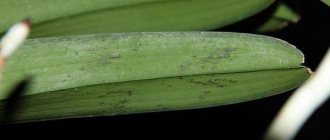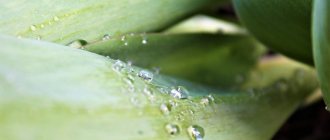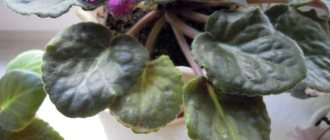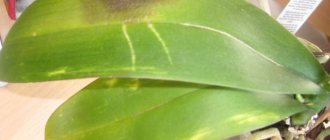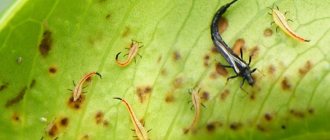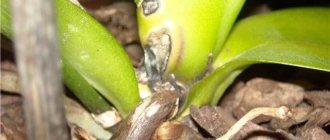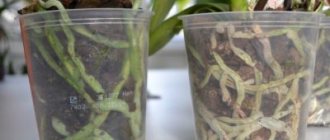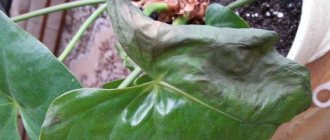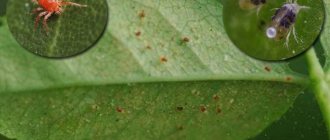Types of pigmentation
Pigmentation can be distinguished by several types of characteristics:
- size (there may be absolutely unnoticeable spots, which at a long distance in large numbers appear to be one large spot, and sometimes very large inclusions appear);
- color (all shades of yellow, brown, dark and black are found);
- shape (most often these are round spots, but the edges are not always smooth; they can be smooth, convex or, conversely, concave).
Photo
You will see a photo of black and other dots on the flower:
Which inclusions are dangerous and which are not?
It is very difficult to say exactly what is dangerous for a plant. However, most often, if the inclusions are barely noticeable (small in size or the color of the pigmentation is not very different from the phalaenopsis area), this indicates that they are most likely not a cause for concern.
Reference! It's important to keep an eye on these types of spots because they can develop into something more serious. The main thing is to notice changes in time and take measures to eliminate them.
What to do with a Phalaenopsis flower?
When the first spots are detected, you must follow simple emergency rules for orchids:
- Isolate the suspicious plant from healthy specimens.
- Find out the cause of pigmentation.
- Start implementing a set of therapeutic measures.
First aid
First aid for phalaenopsis begins with determining the cause of infection:
- reduce the watering and spraying regime, observing the leaves;
- the spot does not change its size - no medications will be needed, it is enough to reconsider the agricultural management techniques;
- it gets wet and grows: apply fungicide treatment;
- remove damaged areas;
- treat the cut with activated carbon;
- disinfect all tools, equipment, pots, etc.
Peculiarity! Quarantine is maintained for several weeks after the stains disappear.
Drugs
In the gardener's first aid kit there will be a place for drugs that help get rid of infectious agents and pests:
- foundationazole is an antifungal agent with a pronounced acaricidal and insecticidal effect;
- phytosporin – a microbiological preparation against fungal and bacterial infections;
- Bordeaux mixture - a copper-containing solution with a fungicidal effect;
- Promanal - to protect the plant from mites and scale insects;
- Fozalon is an enteric-contact poison for pest control.
Their use is justified if pigmentation on the leaves is caused by a fungal infection, or is associated with the activity of arthropod pests.
5/5 — (1 vote)
Reasons for appearance
There can be many reasons for such a negative process in the life of a plant. Let's call them:
- Burning by the sun's rays. To avoid this, you need to choose the right location for your beauty. There should be a lot of light, but it should be diffused.
- Incorrectly selected watering mode. Often it is excessive soil moisture that leads to spots on the plant. This occurs due to rotting of the root system.
- Poor air and water circulation in the pot. A drainage layer will help ensure the movement of air and water in the flower container. Its height should vary between 1.5-2 centimeters. You also need to make sure there are holes at the bottom of the pot.
- Lack of fresh air in the room. The room needs to be ventilated regularly. However, this procedure should not turn into drafts. Everything should be in moderation.
- Mistakes in choosing a pot. The container for phalaenopsis should be a couple of centimeters in diameter larger than the volume of the entire root system. This will ensure normal growth and healthy development for the roots (you can learn more about how to care for orchid roots to keep them healthy here).
Poor quality substrate. The soil should be intended exclusively for the Orchid family. Others won't work. It is necessary to ensure that after moistening the soil does not form lumps, and also that bark is present in the soil mixture.- Improper use of fertilizer. Often the gardener, wanting even faster growth, development and flowering of phalaenopsis, overdoes it with fertilizing. Under no circumstances should this be done. It is important to strictly follow the instructions for use.
How to cure?
Treatment of the plant should be started immediately after the first symptoms are detected and the flower is examined.
Chemicals
Chemicals are an essential component of any orchid treatment.
In the garden store you can find many effective remedies that will help defeat not only infections, but also pests. The following formulations will help get rid of stains on leaves:
- fungicides;
- Fitosporin;
- Fundazol;
- Pure flower;
- antibacterial drugs;
- antiseptics;
- compositions containing copper;
- Bordeaux mixture;
- Quadris;
- Aktara, Aktellik, Nurell-D (intestinal poisons);
- Fozalon (contact poison);
- I cheated.
But before using any chemical, you need to carefully study the instructions for use. Even if you are confident in your experience in matters of floriculture, you should not neglect the rules and recommendations. It is better for beginning flower growers not to rely on themselves, but to consult with specialists. They will help you avoid mistakes when treating phalaenopsis.
You need to purchase all chemical preparations for plants only in specialized stores, since this way you will avoid purchasing counterfeits.
Traditional methods
Not all gardeners are willing to use chemicals when treating their plants. They prefer less effective but safer traditional methods. First of all, you need to isolate the sick orchid from healthy flowers and provide it with proper care. Monitor the temperature and humidity in the room; during illness, phalaenopsis is especially sensitive to any changes.
Popular folk methods for treating spots on orchid leaves:
- You can treat the leaves with ground cinnamon or activated carbon. They have antibacterial and healing effects.
- Many also use iodine on damaged areas of the leaf blade. But this method of dealing with defects will only be effective if the disease has not yet started.
- When fighting harmful insects, some gardeners use a soap solution. You can treat the leaves with it to wash away pests.
Danger to the flower
Any change in the appearance of the plant, including the appearance of inclusions, is a sign of the development of a disease. This can happen due to improper care, and sometimes the disease is transmitted from a diseased flower to a healthy one. The disease leads to the death of the flower completely or the death of some part of it. Therefore, the main task of the gardener is to monitor the appearance of the phalaenopsis and respond in a timely manner to the slightest changes.
Causes of problems at home
The beginning of the development of the disease can be tracked by the leaves of the plant. They instantly react to any negative processes.
Orchids are susceptible to many diseases. Conventionally, they can be divided into four large groups:
- Infectious diseases - the causative agents are fungi that develop in excessively moist soil and unventilated areas. If conditions do not change, fungi develop very quickly. The roots begin to rot first, then the stems and leaves.
- Non-infectious diseases are a consequence of the orchid being exposed to low temperatures. The plates react to such conditions with dark spots.
- Diseases caused by bacteria develop in conditions of stagnant moisture in the soil and air. Bacteria penetrate into the orchid through damaged areas of a weakened plant and disrupt its metabolic processes. All this quickly leads to necrosis.
- Diseases that develop after viral exposure are the most dangerous. A plant infected with a virus should be destroyed immediately so that neighboring flowers are not harmed. A viral disease can only be detected in a special laboratory. The disease appears as spots on the outside of the plates and stem. The most common are: cymbidium mosaic virus, viral spot virus, ring mosaic virus.
Step-by-step instructions for treating inclusions caused by diseases
Bacillus Cypriped
It is necessary to begin the fight against such a disease immediately, since its negative impact spreads at a rapid speed and leads to the death of the flower.
How to recognize? Spots begin to appear on the edge of the leaf blade and literally reach its base in a day or two. In addition, the leaves lose their turgor and emit a characteristic unpleasant odor.
The most optimal way to combat Bacillus Cypriped is to remove the affected leaves and one-time spraying with insecticides.
Hives
Characteristic signs are miniature spots, the diameter of which does not exceed three millimeters, of a brown hue. Hives usually spread only on the leaves (you can learn more about what other diseases can occur on the leaves of the phalaenopsis orchid and how to treat them here).
To eliminate this disease, the grower must:
- increase the air temperature in the room to the optimum (in summer it is 22-26, and in winter – 18-23);
- increase the air humidity level to approximately 70%.
Late blight
You can recognize this disease by the following sign - black rot at the base of the leaf, which gradually spreads over its entire area. The danger of late blight lies in the fact that its pathogenic spores can persist in the soil for a long time.
It is almost impossible to save a plant after infection with this disease. Therefore, it is necessary to adhere to the following rules that will help avoid late blight:
- keep air humidity at 70-75%;
- do not overcool phalaenopsis;
- Make sure that after watering no drops of water remain on the surface of the plant.
Dry spots
This pigmentation can be either dark or light. However, it is impossible to cure a flower from dry spots. Because usually such inclusions are signs of burns. You can get rid of them by removing the burned area or the entire part of the plant. It's best to avoid dry patches. This can be done by following simple recommendations:
- in cold weather, make sure that the plant does not have direct contact with heat sources (this can be heating or lighting devices);
- starting in spring, make sure that direct rays of the sun do not fall on the phalaenopsis (it is better to generally move the flower to the eastern or western side of the room, or shade it).
Reference! In rare cases, dry spots appear due to an attack of fungal infections. In such a situation, the plant is treated with a fungicidal agent, and in the future the grower must control the air circulation in the room.
Mesophyll collapse
A characteristic feature of this disease is uneven spots of a yellow tint, which also have dented leaves (read more about why the leaves of the phalaenopsis orchid turn yellow and what to do to save them).
Botanists say that Mesophyll collapse appears due to watering or spraying phalaenopsis with water at low temperatures.
How can you tell when a plant is sick and when pests appear?
It is possible to determine whether a plant is sick or is suffering from pests only through a thorough examination.
Signs of infection:
- If dark spots or brown spots (with or without a rim) appear on the leaves, then the plant has been affected by rot.
- If the plant has turned yellow at the base, dried out, or the surface of the leaves has wrinkled, the orchid is suffering from improper care. Treatment is carried out through restoring the light regime and proper watering.
- If first light and then brown streaks appeared on the flower, gradually merging into stripes, and the leaves turned yellow and began to fall off, then the phalaenopsis was attacked by a virus.
Signs of pests:
- Flowers and inflorescences changed color and began to fall off, and uneven silver spots appeared on the leaves.
- White lumps collect in the axils of the leaves.
- Shoots and leaf blades are covered with brown growths with warts (they are easy to remove). This indicates the presence of scale insects or false scale insects.
- The appearance of stains accompanied by stickiness.
- The appearance of red dots on the surface of leaf blades and/or the covering of shoots and leaves with a whitish tint.
Methods of treatment if the pathogen is bacteria
Phyllostictina Pyriformis
When infected with this bacterium, pigmentation appears on the plant (it can be either yellow or black). The size of such spots does not exceed a few millimeters. A distinctive feature of these inclusions is the fact that they do not grow for a long time. This is where the danger lies. Because during such “stagnation” the bacterium develops inside the tissue. And after that the leaf plate dies. This occurs approximately 10-15 days after the spots appear.
What can you do with the flower to eliminate yellow or black spots? Unfortunately, it will not be possible to save an orchid after infection. But it is possible to prevent the appearance of Phyllostictina Pyriformis. To do this, you need to ensure that the water in the pot does not stagnate.
Burkholderia gladioli
In our climatic conditions, such a bacterium is extremely rare. This pest leads to darkening of almost the entire surface of the leaf (read about what other pests of phalaenopsis orchids you should be wary of here).
Reference! The lesion is similar to frostbite.
To avoid infection, you need to control the air temperature in the room, preventing it from cooling.
Chlorosis
Signs of damage are large spots that do not have a clear boundary. Their color is light. Chlorosis is not considered a disease, but rather a precursor to it.
This bacterium appears for many reasons: both due to erroneous soil moisture and due to an incorrectly selected fertilizer complex.
An orchid is a finicky flower and, as a result, roots and other parts of the plant may dry out, leaves, flowers and buds may wither, and a sticky coating may appear. How to treat and save a flower using the root extension method - read on our Internet portal.
Symptoms of common diseases with photos
Each disease has characteristic symptoms, by analyzing which you can accurately diagnose the problem and help the flower.
Anthracnose
A sign of an orchid infection with anthracnose is black spots with a yellow edging on the leaves, which gradually increase in size and merge. The causative agent of the disease is a fungus of the genus Colletotrichum, which develops on the plant under conditions of high air and substrate humidity.
Initial infection by fungal spores occurs through the air. Relocation occurs from diseased plants, through hands or tools. The incubation period of the disease is 4-10 days. Temperatures above 25 degrees are sufficient for rapid reproduction of spores.
Powdery mildew
The disease manifests itself as a whitish coating on the leaves: they seem to be sprinkled with a thin layer of flour. The main factors for the development of the disease are high humidity combined with moderate temperature. The plaque makes it impossible for the leaves to breathe normally, and they begin to deform and then dry out. A progressive disease can destroy an orchid in 1-2 months.
Bacterial points
Bacterial spotting is dangerous for orchids planted in poor-quality or contaminated substrate. The disease actively develops when lighting is too bright, improper watering and fertilizing.
The first symptom of infection is yellowness on the leaf blades along the edges. Gradually, the leaves become dark, lose their shape, and become covered with cracks. Weeping areas appear in places where bacteria accumulate.
Fusarium
This type of rot causes the rapid death of an infected orchid. The provoking factors of the disease are stuffy conditions combined with waterlogging. The leaves gradually turn yellow, then curl and lose their shape. In the late period of the disease, a pinkish tint appears on them.
Black rot
Black rot fungus most often affects orchids. Typically, spores settle on young plants. The provoking factor is infection of the plant by insect pests. Symptoms of black rot are asymmetrical spots of a dark brown or black hue. As the fungus multiplies, the orchid completely darkens, dries out and dies.
Edema
The disease appears as transparent growths or swellings on the underside of leaves. Sometimes they are surrounded by a wet rim. The cause of the disease is an excess of moisture in the plant due to excessive moisture in the substrate and air. The tissues of the flower simply cannot process the water entering them and begin to swell.
Often the disease develops as a result of watering an orchid located in a cold room or in a draft. Many flower growers do not classify edema as a disease, so no treatment methods have been developed for it. It is enough to follow the rules of care and requirements for living conditions.
Rust on leaves
Among all the fungal diseases of orchids, rust is the least common. Spores settle in the soil and, when favorable conditions occur, settle on leaves and shoots. As a result, they become covered with light spots, similar to burns. The fungus first attacks old, weakened parts of the plant, then spreads to young leaves and shoots.
Sticky spots
The formation of a sticky coating on orchid leaves occurs for several reasons:
- Transpiration is the appearance of flower nectar on the surface after the processing of sugars inside the tissues. The plant produces sticky spots to attract insects. But in addition to being useful, they also attract pests, so they pose a serious danger to the orchid.
- A combination of too bright lighting, water accumulation in the pan and low temperature.
- Overfeeding in combination with high substrate humidity.
- Infestation with insect pests: scale insects, aphids, mites.
- The beginning of the development of powdery mildew fungus.
Important! A sticky coating on the leaves may also indicate an orchid infection with aphids.
Bumps and bumps
Swellings on orchid leaves: tubercles or pimples are mycelium in its infancy. When favorable conditions occur, spores and mycelia begin to spread throughout the plant. They cannot be opened. It is necessary to cut off the affected leaves as soon as possible to prevent the spread of the disease.
Sometimes the tubercles are evidence of an adult female pseudoscale insect settling on the leaves. Adult pests feed on juices from plant tissues and leave a viscous, sticky liquid on them, which creates conditions for the development of rot and fungi.
Shchitovka
The most common and most dangerous pest of orchids, it forms small, hard, brown or black growths on leaves and stems. An adult insect is the size of a match head. It literally attaches tightly to the leaf and sucks the juices out of it. If the scale insect is torn from the leaf, a small wound remains on the leaf, which subsequently serves as an entry gate for infection.
The eggs laid by the female hatch into larvae no larger than two millimeters in size. The result of their vital activity is numerous dark depressed spots and a viscous, sticky liquid that attracts other pests to the plant.
Prevention
It is easier to prevent any problem than to solve it later. The same is true with spots on phalaenopsis. They can be avoided by adhering to the following rules:
- Proper watering. Moisten the soil again only after it has stood dry for 2-3 days. Flower growers recommend watering phalaenopsis using the immersion method.
- Comfortable air temperature. Do not forget about the mandatory difference in waste temperature (the difference is approximately 4-5 degrees).
- Light mode. It is necessary to provide lighting for the plant for 10-12 hours a day. But be careful that direct sunlight does not fall on the flower.
- Feeding. Phalaenopsis should be fertilized twice a month. It is worth stopping feeding during flowering.
- Soil selection. It should contain bark, moss, river sand and peat. And also do not forget about a good drainage layer.
All these recommendations will help the gardener maintain the health and beauty of his pet.
Popular questions when growing orchids
The process of growing an orchid is long. During the growth of a flower, you may encounter problematic situations that are important for the normal development of the plant.
Why do orchid flowers wither? The most common reason is creating an unsuitable climate for the plant. The buds may be exposed to direct sunlight. The plant gets tissue burns.
Low temperatures also cause flowers to wilt. To normalize, it is necessary to increase the temperature in the room and provide ventilation.
How to revive an orchid if the roots have rotted? Root rot is dangerous because it damages the area that allows for the absorption of liquid and beneficial microelements. If the rhizome of the plant is partially rotten, then cut out all the affected areas to healthy tissue and treat with 3% copper sulfate.
If the orchid root has rotted completely, the entire suspicious infected part of the plant is cut out. The cut site is treated with a fungicide or a weak solution of potassium permanganate. After this, the orchid without roots is placed in a greenhouse with an optimal climate for it so that the process of formation of new roots begins.
You can also grow orchid roots in water. To do this, the treated part of the plant is placed in a vessel with boiled water so that only the lower part of the orchid is in the water, without touching the leaves. At night, the plant is taken out of the water and dried. Adding sugar to the water will help speed up root formation.
Reanimation of an orchid without roots in water
The orchid's leaves are withering: what to do? If the process is associated with unsuitable climatic conditions, it is necessary to adjust the humidity and temperature in the room. You need to stop feeding for a while.
Wilting of foliage may be associated with the effects of viruses on the plant. In this case, it is recommended to get rid of completely wilted leaves by treating the sections with activated carbon.
How to save an orchid without roots? You can revive an orchid without roots by growing a new rhizome. The process requires medications that can be purchased in special stores.
Before resuscitation begins, it is necessary to prepare the plant. To do this, rotten sections of the rhizome are removed in advance, after which the orchid is dried for 8 hours. A drug (Kornevin) is applied to the cut sites and the neck of the orchid.
An activated carbon tablet is dissolved in 0.2 liters of clean water. The orchid is placed in a container and kept in a warm place until new roots appear. Once the rhizome has formed, the plant can be planted in the substrate.
The orchid does not bloom: what to do? First you need to create favorable conditions for the plant to bloom: reconsider the location of the orchid and the amount of watering. Excess and lack of light affects the appearance of buds in the plant.
If the root system is exposed to fungus, then the flowering process will not occur. It is recommended to replant the plant by first removing the affected areas of the rhizome and treating it with activated carbon.
White plaque on orchids: how to treat? To get rid of white plaque, you need to disinfect the surface of the leaves with a soap solution. Treat the soil with Fitoverm or similar products.
The orchid has dropped all its leaves: what to do? The reasons for the sudden loss of foliage are insufficient or excessive watering, high temperature, the negative impact of fertilizing and damage to the rhizome. It is necessary to check the substrate and roots of the plant. If there are signs of rotting, then you need to cut out the diseased areas and replant the orchid.
Why does an orchid shed its buds? The shedding of buds by an orchid is associated with a stressful state. Most likely the problem lies in an adverse effect on the plant from the external environment (bacteria, viruses, etc.) or a sudden change in the location of the flower.
The peduncle of an orchid has dried up: what to do? In a healthy flower, the peduncle dries up after the orchid has bloomed. It is necessary to remove the peduncle after it has completely dried out to allow a new one to develop. If the process is not associated with the natural growth of the plant, then it is recommended to reconsider the rules for watering the orchid.
Why do orchid leaves crack? Cracks on the leaves are one of the signs of deformation. One of the reasons is excessive use of fertilizers and excessive or insufficient watering. Possible mechanical impact on the plant: careless transportation, etc.
The roots of an orchid are rotting: what to do? When roots rot, it is necessary to determine the cause (most often - a large amount of moisture). Reduce the volume of infused liquid, you can soak the rhizome, first eliminating the infected areas.
Why do the tips of the orchid's leaves turn black? Blackening is associated with leaf scorch. The plant requires diffused light; direct rays are destructive. During restoration, it is recommended to limit the supply of nitrogen fertilizers.
The orchid has wrinkled leaves: what to do? If the process is not associated with the natural aging of the plant, then infection of the root system with a fungal disease is possible. It is necessary to determine the type of disease, then remove and treat the diseased roots with special preparations. The orchid may need resuscitation if the root is completely infected.
Orchid leaves are rotting: what to do? It is necessary to cut out rotting places and first review the microclimate of the room. Treat sections with activated carbon or fungicide and carry out preventive measures. Rot is easily transmitted through water droplets, so it is recommended to check neighboring flowers.
An orchid is a rather capricious plant. But it can be easily dealt with if you know how to properly treat the roots and leaves of the plant. It is also important to maintain a normal indoor climate.

